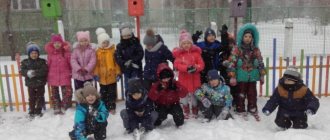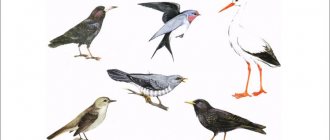Project “Feed the birds in winter” 1st grade
Crow
– body length 58-62 cm, weight of males 1100–1550 g, females 800–1315 g. The plumage is uniform black, with a metallic sheen. The beak is very powerful and sharp. The colors of the male and female are the same. Life expectancy is a record for birds - 50–75 years, but there is evidence of even longer periods. Often found near human habitation and in landfills. Leads a sedentary lifestyle. Nests in forests, parks, and floodplain plantings. Nests are located in trees. Omnivorous. They eat insects, seeds, carrion, catch rodents and other small animals, and fish. Destroying the nests of other birds, they eat eggs and chicks. They are very careful and avoid people. However, in captivity they are easily tamed and are even capable of imitating human speech.
Woodpecker
— body length — 23–26 cm, weight — 70–100 g. Black and white tones predominate in color, males have a red nape. Young males have a red cap on their heads. The top is black with white streaks, the bottom is white with red undertail. The woodpecker's legs are short and very strong, with tenacious claws, two toes point forward, two toes point back. The beak is straight (rarely slightly curved), used for hollowing out hollows for nests and for splitting bark in search of food. Nests in trees suitable for making cavities. In summer it feeds mainly on tree insects. With strong blows, he breaks the bark, exposing the passages of insects, and with a sticky long tongue, which easily penetrates these passages, he removes larvae and adult insects. In winter it feeds on pine and spruce seeds. With blows of its beak, the woodpecker opens the scales of the cone, extracts and eats the seeds
Bullfinch
- one of the most widely known migratory birds in Russia. The male bullfinch is a red-breasted bird with a bluish-gray back and a black head, while in females the red color is replaced by brownish-gray. Significantly larger than a sparrow: it weighs 32–34 g. The bullfinch feeds on seeds of trees and herbs, and berries. Insects and spiders - only as additional food. Parents feed the chicks with softened seeds. In winter they eat the buds. The bullfinch is a trusting and sociable bird.
Tit
– its body length is 14 cm. The head is black with white cheeks and the back of the head, the dorsal side is greenish (less often bluish), the abdomen is bright yellow with a black longitudinal stripe, wider in males and young birds. Lives in forests and parks. More often than other tits, it settles next to humans. Looks for insects and spiders on branches and trunks. In winter it feeds on seeds and other plant foods. A common visitor to feeders in city parks.
Pigeon
— body length — 30–35 cm, weight 260–380 g. Pigeons have 28 color varieties. She is usually gray-gray, with purple, copper-red and green tints on her neck. Light loin, almost white inner side of the wing, two solid black stripes on top of the gray wing. There is no feathering around the eyes. The beak is black, with a whitish cere at the base. “Semi-domesticated” pigeons live in populated areas, near human habitation. They feed on various seeds, grains, berries, and fruits of fruit trees. Pigeons living near people easily adapt to eating human food waste and waste grain.
Pedagogical project in the middle group of kindergarten on the topic: Feed the birds in winter
Pedagogical project in the middle group on the topic: “Feed the birds in winter.”
This project will be useful for teachers of preschool children, additional education teachers, and pedagogical students. Project name: “Feed the birds in winter” Author : teacher of the middle group of the kindergarten “October Kindergarten” Tatyana Leonidovna Vasilkova. Duration of the project : short-term 2 weeks from November 11 to November 28. Type of project : educational, informational, productive. Project participants : children, parents, teachers. Children's age : 3-5 years. The problem is significant for children, the solution of which the project is aimed at: Forming in children elementary ideas about wintering birds of their native land. In our case, the Kaluga region. Children have not developed knowledge about the names of birds, wintering and migratory birds. Children have a small amount of knowledge about the habitat of birds, why they need to take care of them in winter, and how they themselves can help the birds. Relevance of the project : 2022, by decree of our President V.V. Putin, was declared the Year of Ecology in Russia. In the rapidly developing modern world, the problem of environmental education of modern preschoolers is becoming especially acute and relevant. After all, it is in this sensitive period that preschoolers develop their personality, and it is important during this period to have time to form love and care for living nature, to learn to take care of the world around them. Knowledge about the world around us acquired in preschool childhood arouses in children a deep, sincere interest in it, expands knowledge, contributes to the formation of character and love for living nature. Also, during the cold season, there is less and less food for birds, as a result they may even die, which cannot be allowed! The task of adults (teachers, parents) is to cultivate interest, care, a desire to learn new facts about their lives, to experience the joy of realizing that they themselves can, by sharing crumbs, save birds from death. Project goal : To form children's understanding of wintering birds, their lifestyle, and what to feed them. Create conditions for the development of cognitive interest. Project objectives: Educational : To give children an idea of the wintering birds of their native land (Kaluga region). Expand and deepen the knowledge of preschoolers on the topic: “The life of birds in winter” Activate children’s vocabulary with terms from the project topic. Developmental: Develop thinking, memory, fine motor skills, coherent speech. Develop creative abilities in productive activities. Develop curiosity and interest in living nature. Educators: Foster a caring attitude towards birds, a desire to help them in difficult cold conditions. Cultivate friendly relations in the children's team. Promote the formation of interest in the world around us. For the teacher: A. To give children knowledge about wintering birds of the Kaluga region. B. Develop curiosity, “living” interest. B. Expand children’s knowledge of wildlife, the habitat of wintering birds and their way of life. D. Develop children's creative abilities. Expected result : A. Improve the level of children's knowledge about the world around them, about wintering birds. B. Formation of a caring attitude towards living nature in children. B.Increasing the level of knowledge of parents. D. Making bird feeders by parents. D. Showing interest and interest of children together with their parents in caring for birds and the desire to help them in the winter. Product of the project activity : A. Performing collective work in non-traditional mixed media (Painting with a palm, a cotton swab and an imprint of a plastic cork) with paints: “Bird's Canteen” B. Drawing with gouache: “Bullfinch” C. Presentation “Migratory and wintering birds” D. Folder -movement “November 12th Titmouse Day” D. Plasticineography “Bullfinch on a Rowan Branch” E. Making a feeder from a toilet paper roll. E. Decorating patterns of bullfinch, titmouse, sparrow. G.Applique bullfinch. 3. Parents making bird feeders. I. Modeling a sparrow. Project implementation: Preparatory stage : A. Determine the topic of the project. B. Formulate the goals and objectives of the project. B. Draw up a project implementation plan. D. Selection of visual and informational material for the implementation of the project. D. Selection of material for productive activities. Main stage . A. Examination of illustrations and books on the topic of the project. B. Conducting a GCD on the surrounding world: “Birds of the native land” B. Conducting a GCD on the surrounding world: “November 12th Titmouse Day” (as a result of the lesson, the children made mini-feeders from waste material) D. Conducting a GCD on HER application topic : “Bullfinch” D. Carrying out GCD JSC KHER gouache painting: “Bullfinch” E. Carrying out GCD in music with listening and learning the song “Sparrow” J. Viewing the presentation: “Migratory and wintering birds” H. Learning a poem: E. Evseeva Tit, tit, what are you dreaming about? I. Conducting finger gymnastics: “A snowflake sat on a branch...”, “I’m knocking on wood...” K. Consultation for parents: “How and from what you can make a feeder” L. Conducting a competition for families of pupils to make feeders: “Feed birds in winter" M. Carrying out GCD on HER plasticineography "A bullfinch on a rowan branch. The final stage. A. Performing group work in non-traditional mixed media (Painting with a palm, a cotton swab and a print of a plastic cork) with paints: “Bird's dining room” B. Conducting educational activities around the world: “How can we help wintering birds?” B. Summing up the results of the feeder competition. D. Hanging feeders. We hung one feeder outside the window of our group. D. Observing birds at feeders. Result. As a result, the work turned out to be voluminous and informative. Project activities are planned taking into account the integration of areas, helping children to master and comprehend new knowledge. Which were given to them by their parents and teachers. Expanding your horizons and ideas about wintering birds. The general level of children's knowledge about the world around them has increased. Children acquired specific knowledge about living nature. They began to share the information they received with other children! Parents became interested in the resulting products of the project.
We recommend watching:
Project in the middle group “Through the pages of Bazhov’s tales” Project. Development of role-playing games in the middle group of kindergarten Children's research work project "Indoor plants." Middle group Winter project in the middle group of a preschool educational institution on the theme “Tit”
Similar articles:
Card index of walks in the middle group according to the Federal State Educational Standard for January with goals
Card index of walks in the middle group according to the Federal State Educational Standard for December with goals
Card index of walks in the middle group according to the Federal State Educational Standard for February with goals
Observation “Footprints in the snow.” Middle group
Walk observation in winter in the middle group. Winter clothes




